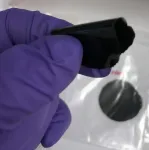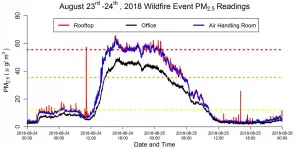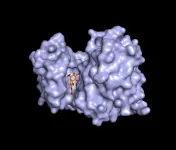(Press-News.org) As electronic devices saturate all corners of public and personal life, engineers are scrambling to find lightweight, mechanically stable, flexible, and easily manufactured materials that can shield humans from excessive electromagnetic radiation as well as prevent electronic devices from interfering with each other.
In a breakthrough report published in Advanced Materials--the top journal in the field-- engineers at the University of California, Riverside describe a flexible film using a quasi-one-dimensional nanomaterial filler that combines excellent electromagnetic shielding with ease of manufacture.
"These novel films are promising for high-frequency communication technologies, which require electromagnetic interference shielding films that are flexible, lightweight, corrosion resistant, inexpensive, and electrically insulating," said senior author Alexander A. Balandin, a distinguished professor of electrical and computer engineering at UC Riverside's Marlan and Rosemary Bourns College of Engineering. "They couple strongly to high-frequency radiofrequency radiation while remaining electrically insulating in direct current measurements."
Electromagnetic interference, or EMI, occurs when signals from different electronic devices cross each other, affecting performance. The signal from a cell phone or laptop WiFi, or even a kitchen blender, might cause static to appear on a TV screen, for example. Likewise, airlines instruct passengers to turn off cellphones during landing and takeoff because their signals can disrupt navigation signals.
Engineers long ago learned that any electrical device could possibly influence the functioning of a nearby device and developed materials to shield electronics from interfering signals. But now that electronic devices have become ubiquitous, small, wirelessly connected, and critical to innumerable essential services, the opportunities for and risks of EMI-caused malfunctions have proliferated, and conventional EMI shielding materials are often insufficient. More electronic devices mean humans are also exposed to greater electromagnetic radiation than in the past. New shielding materials will be needed for the next generation of electronics.
Balandin led a team that developed the scalable synthesis of composites with unusual fillers-- chemically exfoliated bundles of quasi-one-dimensional van der Waals materials. The composites demonstrated exceptional EMI shielding materials in the gigahertz and sub-terahertz frequency ranges, important for current and future communication technologies, while remaining electrically insulating.
Graphene is the most famous van der Waals material. It is two-dimensional because it is a plane of strongly bound atoms. Many planes of graphene, weakly coupled by van der Waals forces, make up a bulk graphite crystal. For many years, research was focused specifically on two-dimensional layered van der Waals materials, which exfoliate into planes of atoms.
One dimensional van der Waals materials consist of strongly bound atomic chains, rather than planes, which are weakly bound by van der Waals forces. Such materials exfoliate into needle-like "one-dimensional" structures rather than two-dimensional planes. The Balandin group conducted pioneering studies of one-dimensional metals demonstrating their unusual properties. In the new paper, the Balandin group reports using a chemical process that could be scaled up for mass production of these one-dimensional materials.
Doctoral student Zahra Barani and Fariboz Kargar, a research professor and project scientist with Balandin's Phonon Optimized Engineered Materials, or POEM Center, synthesized the unique composites by treating the transition metal trichalcogenides, or TaSe3, a layered van der Waals material with a quasi-one dimensional crystal structure, with chemicals that caused it to shed needle-like, quasi-1D van der Waals nanowires with extremely large aspect ratios of up to ~106-- massively longer than thick. In previous research, the group discovered that bundles of quasi-1D TaSe3 atomic threads can support high-current densities.
"There was no standard recipe for exfoliation of these materials. I did many trial and error experiments, while checking the cleavage energy and other important parameters to exfoliate them with high yield. I knew that the key is to get bundles with as high aspect ratio as I can, since EM waves couple with longer and thinner strands better. That required optical microscopy and scanning electron microscopy characterization after each exfoliation step," first-author Barani said.
The researchers filled a matrix made from a special polymer with bundles of the exfoliated TaSe3 to produce a thin, black film. The synthesized composite films, while remaining electrically insulating, demonstrated exceptional performance in blocking electromagnetic waves. The polymer composites with low loadings of the fillers were especially effective.
"The electromagnetic shielding effectiveness of composites is correlated with the aspect ratio of the fillers. The higher the aspect ratio, the lower the filler concentration needed to provide significant EM shielding," Kargar said. "This is beneficial, since by lowering the filler content one would take advantage of inherent properties of polymers such as light weight and flexibility. In this regard, I can say this class of materials are exceptional once they are exfoliated properly, controlling the thickness and length."
"In the end, I got them right, prepared a composite and measured the EMI properties. The results were amazing: no electric conductivity but more than 99.99% of EMI shielding for micrometer thick films," Barani added.
The quasi-1D van der Waals metallic fillers can be produced inexpensively and in large quantities. Balandin said that research on atomic bundles of quasi-1D van der Waals materials as individual conductors, and composites with such materials is just beginning.
"I am sure we will soon see a lot of progress with quasi-1D van der Waals materials, as happened with quasi-2D materials," he said.
INFORMATION:
Barani, Kargar, and Balandin were joined in the research by Yassamin Ghafouri, Subhajit Ghosh, Konrad Godziszewski, Saba Seyedmahmoudbaraghani, Yevhen Yashchyshyn, Grzegorz Cywi?ski Sergey Rumyantsev, and Tina T. Salguero. The paper is called, "Electrically-Insulating Flexible Films with Quasi-One-Dimensional van-der-Waals Fillers as Efficient Electromagnetic Shields in GHz and Sub-THz Frequency Bands."
A federally approved heart medication shows significant effectiveness in interfering with SARS-CoV-2 entry into the human cell host, according to a new study by a research team from Texas A&M University and The University of Texas Medical Branch (UTMB).
The medication bepridil, which goes by the trade name Vascor, is currently approved by the U.S. Food and Drug Administration (FDA) to treat angina, a heart condition.
The team's leaders are College of Science professor Wenshe Ray Liu, professor and holder of the Gradipore Chair in the Department of Chemistry at Texas A&M, and Chien-Te Kent Tseng, professor ...
Climate change impacts are broad and far reaching. A new study by University of Oklahoma researchers from the Institute for Environmental Genomics explores the impacts of climate warming on microbial network complexity and stability, providing critical insights to ecosystem management and for projecting ecological consequences of future climate warming.
"Global climate change is one of the most profound anthropogenic disturbances to our planet," said Jizhong Zhou, IEG's director, a George Lynn Cross Research Professor in the College of Arts and Sciences and an adjunct professor in the Gallogly College of Engineering. "Climate warming can alter soil microbial community diversity, structure and activities, but it remains uncertain whether and how it impacts network complexity and its relationships ...
COLUMBUS, Ohio - If depression is making it more difficult for some unemployed people to land a job, one type of therapy may help, research suggests.
In a new study, 41% of unemployed or underemployed people undergoing cognitive behavioral therapy (CBT) found a new job or went from part- to full-time work by the end of the 16-week treatment for depression.
Those who had a job but found it difficult to focus on and accomplish work tasks because of depression said the treatment helped to significantly reduce these problems.
"For the most part, researchers have focused on showing ...
Just when you thought you could head indoors to be safe from the air pollution that plagues the Salt Lake Valley, new research shows that elevated air pollution events, like horror movie villains, claw their way into indoor spaces. The research, conducted in conjunction with the Utah Division of Facilities Construction and Management, is published in Science of the Total Environment.
In a long-term study in a Salt Lake-area building, researchers found that the amount of air pollution that comes indoors depends on the type of outdoor pollution. Wildfires, fireworks and wintertime inversions all affect indoor air to different degrees, ...
Researchers Learn that Pregnant Women Pass Along Protective COVID Antibodies to their Babies
Antibodies that guard against COVID-19 can transfer from mothers to babies while in the womb, according to a new study from Weill Cornell Medicine and NewYork-Presbyterian researchers published in the American Journal of Obstetrics and Gynecology.
This discovery, published Jan. 22, adds to growing evidence that suggests that pregnant women who generate protective antibodies after contracting the coronavirus often convey some of that natural immunity to their fetuses. The findings also lend support to the idea that vaccinating mothers-to-be may also have benefits for their newborns.
"Since we can now say that the antibodies pregnant women make against COVID-19 ...
The U.S. pulp and paper industry uses large quantities of water to produce cellulose pulp from trees. The water leaving the pulping process contains a number of organic byproducts and inorganic chemicals. To reuse the water and the chemicals, paper mills rely on steam-fed evaporators that boil up the water and separate it from the chemicals.
Water separation by evaporators is effective but uses large amounts of energy. That's significant given that the United States currently is the world's second-largest producer of paper and paperboard. The country's approximately 100 paper mills are estimated to use about 0.2 quads (a quad is a quadrillion BTUs) of energy per year for water recycling, making it one of the most energy-intensive chemical processes. All industrial ...
Large galaxies are known to strip the gas that occupies the space between the stars of smaller satellite galaxies.
In research published today, astronomers have discovered that these small satellite galaxies also contain less 'molecular' gas at their centres.
Molecular gas is found in giant clouds in the centres of galaxies and is the building material for new stars. Large galaxies are therefore stealing the material that their smaller counterparts need to form new stars.
Lead author Dr Adam Stevens is an astrophysicist based at UWA working for the International Centre for Radio Astronomy Research (ICRAR) and affiliated to the ARC Centre of Excellence in All Sky Astrophysics in 3 Dimensions (ASTRO 3D).
Dr Stevens ...
FAYETTEVILLE, Ark. - Cold temperatures, prevalent during glacial periods, had a significant impact on past and modern unglaciated landscapes across much of North America, according to a recent study by University of Arkansas geologist Jill A. Marshall.
Marshall, assistant professor of geosciences, is the first author of the study, published in the journal Geophysical Research Letters.
The findings help shape understanding of the earth's "Critical Zone," the relatively thin layer of the planet that extends from where vegetation meets the atmosphere to the lowermost extent of weathered bedrock. "Climate and ecosystems determine how quickly bedrock ...
DALLAS - Feb. 22, 2021 - Three decades-old antibiotics administered together can block a type of pain triggered by nerve damage in an animal model, UT Southwestern researchers report. The finding, published online today in PNAS, could offer an alternative to opioid-based painkillers, addictive prescription medications that are responsible for an epidemic of abuse in the U.S.
Over 100 million Americans are affected by chronic pain, and a quarter of these experience pain on a daily basis, a burden that costs an estimated $600 billion in lost wages and medical expenses ...
Scientists have identified a way to "rescue" muscle cells that have genetically mutated, paving the way to a possible new treatment for rare childhood illness such as Duchenne Muscular Dystrophy (DMD).
The study, led by the Universities of Exeter and Nottingham, is published in the Proceedings of the National Academies of Sciences, USA. The research used novel drugs being developed at the University of Exeter, which "metabolically reprogram" the cellular energy production centres in muscle cells, by providing them with a fuel source to generate metabolic energy.
DMD is a genetic condition caused by a mutation in a gene called dystrophin which results in progressive irreversible muscular degeneration and weakening. Its symptoms include muscle ...





